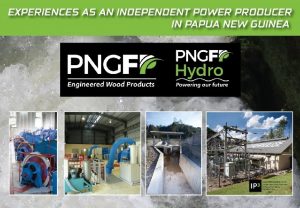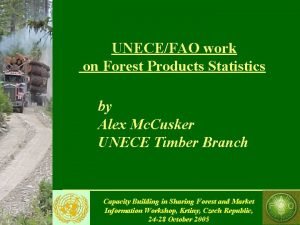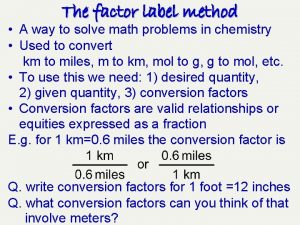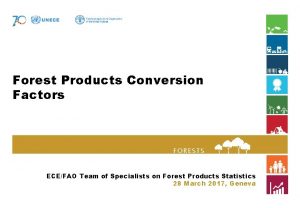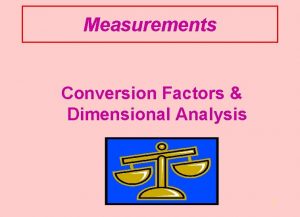Forest Products Conversion Factors FOREST S ECEFAO Team







- Slides: 7

Forest Products Conversion Factors FOREST S ECE/FAO Team of Specialists on Forest Products Statistics 28 March 2017, Geneva

Background of previous work FORESTS • Work on updated conversion factors was requested at the 2008 Working Party Meeting • The late 1980 s was the most recent study prior to 2008 • Completed in January 2010 and resulted in publication ECE/TIM/DP/49 • Factors from 16 countries and one trade association (all from the UNECE region) • Differed from past efforts: explanatory text, more products and sub-products 2

Conversion factors from the FAO Statistical Yearbook vs DP-49 FORESTS 3

New conversion factors project FORESTS • Joint FAO/ITTO/UNECE - global in scope • Updated and more reliable information with a better harmonization of definitions • Improved conversion factors for wood energy • A credible set of conversion factor from BF log rules to m 3 for the North American subregion • Credible, national and regionally defined conversion factors for actual to nominal measurement forest products • Questionnaires sent out 4/2016; completion late 2017 4

Why is it important? FORESTS • We use conversion factors everyday for converting from one unit to another for reporting and analysis (e. g. JFSQ, JWEE) • There is a need at the international level for a set of harmonized, impartial, reliable and reasonably accurate conversion factors • There is a strong demand (we receive many requests) • Conversion factors change over time and need to be revised • Conversion factors are needed to construct a wood balance Recovery = 63. 9% Recovery = 71% 5

New conversion factors project Status of respondents FORESTS Europe/CIS/North America Submissions Expecting Austria (update) Canada (update) Croatia Portugal Czech Republic (updated) Russian Federation Denmark (New) Serbia Finland (updated) Slovenia France (updated) Ukraine Germany (updated) Ireland Lithuania Moldova (new) Netherlands (updated) Norway (updated) Romania (new) Slovakia Spain Sweden Switzerland United Kingdom (updated) United States (update of mbf only) Hoping for Belarus Belgium Latvia Lithuania Poland Slovakia Switzerland (update) Submissions Guyana Japan Madagascar Mexico Suriname Outside the Region Hoping for South Africa Nigeria Ethiopia Democratic Republic of the Congo Uganda Ghana United Republic of Tanzania Cameroon Côte d'Ivoire Egypt Mozambique Gabon Zambia Congo Kenya Costa Rica El Salvador Honduras Guatemala Brazil Chile Argentina Colombia Paraguay Uruguay Ecuador Venezuela (Bolivarian Republic of) Peru Bolivia (Plurinational State of) Guyana China Japan India Indonesia Malaysia Thailand Turkey Republic of Korea Viet Nam China, Taiwan Province of Pakistan Myanmar Philippines Australia New Zealand Papua New Guinea Solomon Islands Fiji 6

Thank you! FOREST S Name Surname Position UNECE/FAO Forestry and Timber Section Date March 2017, Geneva


